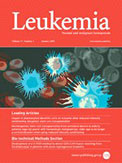Strahm B, Nöllke P, Zecca M, Korthof ET, Bierings M, Furlan I, Sedlacek P, Chybicka A, Schmugge M, Bordon V, Peters C, O´Marcaigh A, de Heredia CD, Bergstraesser E, Moerloose BD, van den Heuvel-Eibrink MM, Starý J, Trebo M, Wojcik D, Niemeyer CM, Locatelli F; EWOG-MDS study group. Leukemia. 2011 Mar;25(3):455–62. IF: 8,296

Abstract:
We report on the outcome of children with advanced primary myelodysplastic syndrome (MDS) transplanted from an HLA-matched sibling (MSD) or an unrelated donor (UD) following a preparative regimen with busulfan, cyclophosphamide and melphalan. Ninety-seven patients with refractory anemia with excess blasts (RAEB, n = 53), RAEB in transformation (RAEB-T, n = 29) and myelodysplasia-related acute myeloid leukemia (MDR-AML, n = 15) enrolled in the European Working Group of MDS in Childhood (EWOG-MDS) 98 study and given hematopoietic stem cell transplantation (HSCT) were analyzed. Median age at HSCT was 11.1 years (range 1.4–19.0). Thirty-nine children were transplanted from an MSD, whereas 58 were given the allograft from a UD (n = 57) or alternative family donor (n = 1). Stem cell source was bone marrow (n = 69) or peripheral blood (n = 28). With a median follow-up of 3.9 years (range 0.1–10.9), the 5-year probability of overall survival is 63%, while the 5-year cumulative incidence of transplantation-related mortality (TRM) and relapse is 21% each. Age at HSCT greater than 12 years, interval between diagnosis and HSCT longer than 4 months, and occurrence of acute or extensive chronic graft-versus-host disease were associated with increased TRM. The risk of relapse increased with more advanced disease. This study indicates that HSCT following a myeloablative preparative regimen offers a high probability of survival for children with advanced MDS.
-im-
